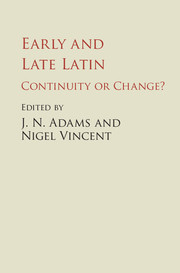Book contents
- Early and Late Latin
- Early and Late Latin
- Copyright page
- Contents
- Contributors
- Preface
- Glossary
- Supplementary abbreviations
- Chapter 1 Continuity and change from Latin to Romance
- Chapter 2 Comic lexicon: searching for ‘submerged’ Latin from Plautus to Erasmus
- Chapter 3 Third person possessives from early Latin to late Latin and Romance
- Chapter 4 The language of a Pompeian tavern: submerged Latin?
- Chapter 5 Ad versus the dative: from early to late Latin
- Chapter 6 Variation and change in Latin be-periphrases: empirical and methodological considerations
- Chapter 7 Analytic passives and deponents in classical and later Latin
- Chapter 8 On the use of habeo and the perfect participle in earlier and in later Latin
- Chapter 9 Expressions of time in early and late Latin: the case of temporal habet
- Chapter 10 Quid ago? Quid facimus?
- Chapter 11 On coepi/incipio + infinitive: some new remarks
- Chapter 12 Infinitives with verbs of motion from Latin to Romance
- Chapter 13 Causatives in Latin and Romance
- Chapter 14 The development of the comparative in Latin texts
- Chapter 15 Analytic and synthetic forms of the comparative and superlative from early to late Latin
- Chapter 16 Left-detached constructions from early to late Latin
- Chapter 17 Six notes on Latin correlatives
- Chapter 18 Epilogue: some patterns of change
- Bibliography
- Subject index
- Index verborum
- References
Bibliography
Published online by Cambridge University Press: 27 October 2016
- Early and Late Latin
- Early and Late Latin
- Copyright page
- Contents
- Contributors
- Preface
- Glossary
- Supplementary abbreviations
- Chapter 1 Continuity and change from Latin to Romance
- Chapter 2 Comic lexicon: searching for ‘submerged’ Latin from Plautus to Erasmus
- Chapter 3 Third person possessives from early Latin to late Latin and Romance
- Chapter 4 The language of a Pompeian tavern: submerged Latin?
- Chapter 5 Ad versus the dative: from early to late Latin
- Chapter 6 Variation and change in Latin be-periphrases: empirical and methodological considerations
- Chapter 7 Analytic passives and deponents in classical and later Latin
- Chapter 8 On the use of habeo and the perfect participle in earlier and in later Latin
- Chapter 9 Expressions of time in early and late Latin: the case of temporal habet
- Chapter 10 Quid ago? Quid facimus?
- Chapter 11 On coepi/incipio + infinitive: some new remarks
- Chapter 12 Infinitives with verbs of motion from Latin to Romance
- Chapter 13 Causatives in Latin and Romance
- Chapter 14 The development of the comparative in Latin texts
- Chapter 15 Analytic and synthetic forms of the comparative and superlative from early to late Latin
- Chapter 16 Left-detached constructions from early to late Latin
- Chapter 17 Six notes on Latin correlatives
- Chapter 18 Epilogue: some patterns of change
- Bibliography
- Subject index
- Index verborum
- References
- Type
- Chapter
- Information
- Early and Late LatinContinuity or Change?, pp. 431 - 457Publisher: Cambridge University PressPrint publication year: 2016



